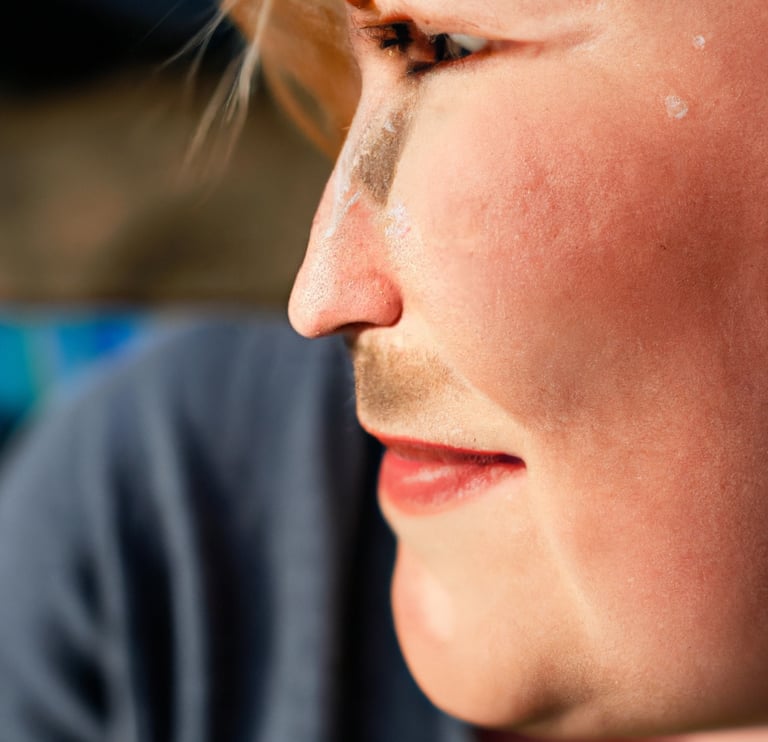Say Goodbye to Whiteheads: Causes, Extraction Techniques, and Treatment
WHITEHEAD
7/30/20234 min read


Whiteheads, those tiny, raised bumps that often appear on the face, can be a frustrating skincare woe. These pesky little bumps can be a source of annoyance and self-consciousness, but fear not – we're here to help you bid them farewell. In this comprehensive guide, we'll delve into the world of whiteheads, unraveling their causes, exploring safe extraction techniques, and revealing effective treatment options. Whether you're a skincare enthusiast or a novice, this article will provide you with the knowledge and tools to say goodbye to whiteheads and welcome a clear, smooth complexion.
Understanding Whiteheads
Before we dive into tackling whiteheads head-on, let's grasp what these sneaky blemishes are:
What Are Whiteheads: Whiteheads, also known as closed comedones, are clogged hair follicles filled with oil, dead skin cells, and bacteria. Unlike blackheads, whiteheads remain closed at the surface, giving them their distinctive appearance.
Common Locations: Whiteheads tend to appear on the forehead, cheeks, chin, and nose – areas with more oil glands.
Causes: Excess oil production, hormonal changes, poor skincare habits, and environmental factors contribute to whitehead formation.
Extraction Techniques - The Do's and Don'ts
While extraction might be tempting, it's crucial to approach it safely to avoid aggravating the skin:
Do: Steam and Exfoliate: Gently steam your face to open pores before extraction. Exfoliate to remove dead skin cells and make extraction easier.
Don't: Use Your Fingers: Avoid using your fingers as this can introduce bacteria and lead to infection.
Do: Use a Comedone Extractor: A comedone extractor is a specialized tool designed for safe extraction. Apply gentle pressure around the whitehead's edges.
Don't: Forceful Squeezing: Never forcefully squeeze a whitehead, as it can damage the skin and cause scarring.
Do: Finish with Toning: After extraction, apply a gentle toner to soothe the skin and minimize pores.
Treating Whiteheads - Your Skincare Arsenal
Discover effective treatment options to banish whiteheads and prevent their recurrence:
Salicylic Acid: A gentle exfoliant like salicylic acid helps unclog pores, making it a staple in your skincare routine.
Benzoyl Peroxide: This powerful ingredient kills bacteria and reduces inflammation, targeting both whiteheads and other blemishes.
Topical Retinoids: Derived from Vitamin A, retinoids promote cell turnover, preventing clogs and fading whiteheads.
Glycolic Acid: An alpha hydroxy acid (AHA) exfoliant that helps remove dead skin cells, revealing clearer skin underneath.
Oil-Free Moisturizers: Opt for lightweight, non-comedogenic moisturizers to keep your skin hydrated without clogging pores.
Your Whitehead-Free Routine
Craft a customized routine to keep whiteheads at bay and enjoy a clear, smooth complexion:
Cleansing: Use a gentle cleanser twice daily to remove excess oil and impurities.
Exfoliation: Incorporate salicylic acid or glycolic acid exfoliants 2-3 times a week to prevent clogged pores.
Treatment: Apply salicylic acid or benzoyl peroxide treatment after cleansing and exfoliating.
Moisturization: Hydrate your skin with an oil-free moisturizer to maintain balance.
Sunscreen: Always protect your skin with a broad-spectrum sunscreen, especially when using exfoliating treatments.
Conclusion: Embrace Your Whitehead-Free Journey
As you embark on your quest to say goodbye to whiteheads, remember that consistency and patience are your allies. While the journey to a whitehead-free complexion may take time, the results are well worth it. By understanding the causes, adopting safe extraction techniques, and incorporating effective treatments into your skincare routine, you're arming yourself with the tools to achieve clear, radiant skin.
Embrace your whitehead-free journey and celebrate each step towards a complexion that exudes confidence and vitality. With dedication and the right skincare arsenal, you're on your way to enjoying a smoother, clearer canvas that reflects your inner beauty.
FAQ
Whiteheads vs. Milia - What Is the Difference?
Whiteheads and milia are both types of small, white bumps that can appear on the skin, but they have distinct characteristics:
Whiteheads:
Whiteheads are a type of acne lesion.
They form when hair follicles become clogged with a combination of sebum (skin oil) and dead skin cells.
Whiteheads are typically surrounded by red, inflamed skin and have a white or yellowish "head" at the top.
Milia:
Milia are tiny, round cysts that often appear as small, white or flesh-colored bumps on the skin.
They are not related to acne and do not have a visible opening or "head."
Milia form when dead skin cells become trapped beneath the skin's surface.
Why do whiteheads appear after waxing the face?
Whiteheads can appear after waxing the face due to various factors related to the hair removal process and skin sensitivity. Here are the key reasons:
Clogged Pores: Waxing removes hair from the root, which can temporarily disrupt the natural shedding of dead skin cells. When these dead skin cells mix with sebum (skin oil), they can clog the hair follicles, leading to the formation of whiteheads.
Skin Irritation: Waxing, especially if done improperly or on sensitive skin, can cause irritation. This irritation can contribute to the development of whiteheads.
Bacterial Introduction: In some cases, whiteheads can result from a bacterial infection. If the skin is not adequately cleansed before waxing or if the waxing equipment is not properly sanitized, it can introduce bacteria to the hair follicles.
Can whiteheads be prevented after facial waxing?
Yes, there are preventive measures you can take to reduce the likelihood of whiteheads after facial waxing:
Skin Preparation: Before waxing, cleanse your face with a gentle, non-comedogenic cleanser to remove dirt, makeup, and excess oil. This helps reduce the risk of clogged pores.
Regular Exfoliation: Regular exfoliation can help prevent the buildup of dead skin cells that can contribute to whiteheads. However, avoid exfoliating immediately before or after waxing, as it can irritate the skin. Exfoliate on days when you are not waxing.
Professional Waxing: If you're not experienced with waxing, consider having it done by a professional esthetician. They can ensure that the waxing is done correctly, minimizing the risk of irritation and whiteheads.
Get in touch
Contacts
contact@visionderma.com
